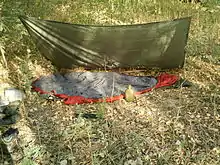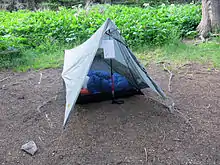Ultralight backpacking
Ultralight backpacking is a style of backpacking that emphasizes carrying the lightest and simplest gear safely possible for a given trip.[1] Base weight (the weight of a backpack plus the gear inside & outside it, excluding consumables such as food, water, and fuel, which vary depending on the duration and style of trip) is reduced as much as safely possible, though reduction of the weight of consumables is also applied.

Although no technical standards exist, the terms light and ultralight commonly refer to backpackers and gear who achieve a base weight below 6.8 kilograms (15 lb) and 4.5 kilograms (9.9 lb) respectively in the Contiguous United States, 3 Season; elsewhere the definitions are commonly given as lightweight being under 15 kilograms (33 lb), and ultralight under 10 kilograms (22 lb). For comparison, traditional backpacking practices often results in base weights above 14 kilograms (31 lb), and sometimes up to 25 kilograms (55 lb).
History
Ultralight backpacking was popularized by rock climber Ray Jardine, whose 1992 book PCT Hiker's Handbook,[2] later retitled as Beyond Backpacking in 1999,[3] laid the foundations for many techniques that ultralight backpackers use today. Jardine claimed his first Pacific Crest Trail thru-hike was with a base weight of 5.7 kilograms (13 lb), and by his third PCT thru-hike it was below 4.5 kilograms (9.9 lb).[3]
Before modern equipment made it easy, there were also hikers who adhered to an "ultralight" mentality. In the late 1800s, George W. Sears (a.k.a. "Nessmuk") hiked and paddled through the Appalachian territory with only a waxed canvas tarpaulin, walking stick / ridgepole, a small pan, and his trademark dual-bladed hatchet. He laid the foundations of ultra-light backpacking in his concise 1884 book, "Woodcraft", which is still in print today.
Another 'early pioneer' was Grandma Gatewood, who thru-hiked the Appalachian Trail in 1955 with only a duffel bag containing an army blanket, a plastic sheet, an umbrella, and other very simple gear much lighter than the heavy equipment common among thru-hikers in those days.[4]
Philosophy and process
A lower base weight allows ultralight backpackers to cover longer distances and simultaneously reduce stress on the body. This is particularly beneficial when through-hiking a long-distance trail. However, gear made from lighter materials that still maintain comparable material strength (such as titanium and DCF) is often much more expensive and sometimes less durable. Thus, many adherents suggest starting with the following steps, in order of ascending weight savings:
- Weigh everything. Weigh every item and record its weight. Identify items that can offer the most weight reduction and track every incremental weight reduction made.
- Reduce each item's weight. Modify items to reduce superfluous weight, replace heavy items with lighter ones, and exchange fully featured items for minimalist (and therefore lighter) items.[3]
- Ration. Carry the minimal amount of consumables needed for a trip. This includes food, fuel, toiletries, etc. This is achieved through estimating amounts consumed each day based on exertion, elevation and personal fitness level.
- Use group gear. If backpacking with others, determine which items can be shared. For example, a group of three may only require a single shelter and cook system. This gear can then be divided among the group.
- Lighten your feet. Hiking shoes are often lighter and less expensive than hiking boots. Switching to less-supportive footwear only becomes possible when pack weight is reduced, i.e. the more a pack lightens, the more becomes possible to lighten.
- Multi-purpose gear. Find items that can be used for different tasks. For example, a poncho can also be used as a shelter, and trekking poles can be used as tent poles. A single bandana has many different uses.
 Poncho shelter
Poncho shelter - Swap gear for skills. Learn and practice skills that can replace equipment. For example, by knowing where to find water, one need not carry as much.
- Increase strength. An often overlooked aspect of ultralight backpacking is personal physical fitness. Basic weight training and endurance conditioning can massively improve comfort and safety on the trail.
- Replace gear. Purchase ultralight gear. This is by far the most expensive step but can offer significant weight reductions. Commonly, an ultralight backpacker will start by replacing their shelter, sleep system, and carrying pack. Tents can be replaced with tarps or bivouacs (bivy), and sleeping bags with down quilts. As base weight is reduced, so does the need for a pack with a frame, so backpackers opt for frameless packs, further reducing total weight.
- Carry less. Omit unnecessary items. Nothing is lighter than nothing.
All these efforts can result in a base backpacking weight that is under 3 kilograms (6.6 lb).[5][6]
Volume of backpack
The backpack volume range from 10-70+L, but it’s always confusing while choosing a backpack when you have a great range. So, choose what is best for you choose according to the time you are going to the mountain. The Essentialist (Day pack) → 0-10 liters, The Transient Traveler (Overnight Trips or Extended Day Hiking) → 10-30 liters, Expedition Edition (Ultra-Light Thru-Hike, Weekend Trip, or International Travel) → 30-50 liters, Going Off The Grid (Multi-Day Backpacking) → 50-70 liters, Pathfinder (Winter Multi-Day Trip or Hiking Guide) → 70+ liters.
Foot weight
Weight on one's feet (from socks, boots, etc.) requires 4–6x times more energy to move than the same weight on one's back. Minimizing footwear weight is the most efficient means to reduce a hiker's total calories burned (i.e. food carried), stress on body, etc.[7][8] For example, Grandma Gatewood wore Keds rather than army boots.
Base pack
The rain shelter, sleeping system, and backpack are considered to be the three major items carried by backpackers. Consequently, reducing the weight of these will reduce overall pack weight.[9]
Rain shelter

Tents, hammocks, and tarps with bivy sacks are used by long distance hikers to protect themselves from the weather. Of these, tents are the most common. The development of Dyneema Composite Fabrics, and very lightweight silicone coated nylon fabrics have allowed manufacturers to produce very lightweight tents. The lightest tents are single wall, but even some double wall tents are very light weight. To further reduce weight, some tents use trekking poles commonly carried by long distance hikers for their main support. Weight can be reduced even more by using poncho-tarps, or the use of a bivy sack (Alpine style) as the sole shelter.[10] Generally as weight decreases, the skill to safely use a shelter increases.
Sleeping system
Reduction in weight of the sleeping system is achieved through reduction of the quantity of fabric used in its manufacture or through use of lighter-weight materials in its construction. Down is a lighter insulation material by volume than currently available synthetic fibers,[3] which will reduce bag weight, but it is susceptible to loft loss caused by moisture.[10] The overall weight of a sleeping bag can be reduced by eliminating superfluous material. An example of this is the use of a sleeping quilt or top bag. A sleeping quilt is a bottom-less insulated blanket which has no insulation on its bottom side, relying on the user's sleeping pad to guard against conductive heat loss into the ground. A top bag is more like a conventional sleeping bag in that it wraps around the user's entire body but the bottom fabric contains no insulation. The idea is that bottom insulation is normally compressed by a person's body weight, rendering any loft in that area useless. Some modern down sleeping bags are through-baffled and under-filled such that the user can shift all the insulation to the top of their body thereby maximizing its potential to retain heat. Ultralight hikers also tend to carry bags rated for warmer temperatures than traditional-weight backpackers, making up the difference on cold nights by wearing insulated clothing to bed, such as a balaclava[3] or an insulated jacket. Proper camping site selection that avoids colder hollows (low points where cold air tends to collect)[3] or that makes use of natural wind barriers such as thick vegetation or cliffs makes up the difference in heat lost by lighter gear.
Backpack
With a lighter shelter and sleeping system, the backpack can consist of lighter material and a less bulky frame or no frame at all. The common ultralight alternative to an internal frame pack is a frameless pack made of ripstop nylon, silnylon, or Dyneema Composite Fabric (DCF), formerly known as Cuben Fiber, with a carrying limit of 11 kilograms (24 lb).[3] An internal-frame pack can weigh upwards of 2.5 kilograms (5.5 lb) with features such as hip belt stabilizers, lifter straps, sternum straps, and compression straps; ultralight frameless packs are commercially available in weights ranging from 200 to 400 grams (8-14 oz)[10] and can consist of not much more than a sack with shoulder straps, a return to the simplicity of the rucksack. Jardine's book includes directions to make your own "ultralight pack".[3]
Some backpackers choose to make their own gear. Advantages to such an approach include possible reduction of cost and the opportunity to customize the gear to the individual user. Additionally, if a homemade item were to break down, the hiker would be in a better position to repair it. Lastly, commercial manufacturers often choose heavier, more durable material for their products in order to reduce the amount of care and maintenance required of the user (and minimize returns of damaged gear). Given proper care, homemade lightweight gear can last as long as it is needed.
Other gear
The remaining gear (such as ten essentials and survival kit) carried by an ultralight backpacker follows a similar philosophy of replacing traditional backpacking gear with lighter options. Replacements include:
- Making a fire instead of carrying a stove.
- Light weight alcohol stoves such as a beverage can stove or solid fuel stoves instead of heavier gas stoves
- Single cook pot ("billycan") with a single spoon instead of a traditional mess kit
- No stove and its associated paraphernalia at all, relying on no-cook meals for food
- Trail running or running shoes instead of hiking boots, and lightweight nylon socks instead of heavy wool socks.
- The minimal amount of extra clothing safely possible.
- Plastic or silnylon bags instead of the conventional (and heavier) packaging that a traditional backpacker might carry.
- A razor blade or a light 1 ounce (28 g) small pocket knife instead of a heavy Leatherman style multi-tool or Swiss army knife.
- Chemical disinfectant water treatment (iodine tablets, chlorine dioxide) instead of heavier water filters.
- Plastic Soft drink or soft plastic bottles instead of heavier nalgene or lexan bottles or Hydration packs.
- A 0.25-ounce (7.1 g) LED light instead of a heavy flashlight or headlamp.
Consumables
In addition to carrying equipment, hikers must also carry consumables such as water and food, and in some cases fuel. Some ultralight backpackers save weight by resupplying these items more frequently. On long-distance trails with multiple access points, some ultralight hikers choose to place food caches or stop at stores to resupply consumables at frequent intervals, allowing just two or three days' worth of food to be carried in place of a larger load.
Water

Water can be a significant contributor to pack weight because moderate activity in a moderate climate requires 2 litres (2.1 US qt) of drinking water per day,[11] with a weight of 2 kilograms (4.4 lb). When traveling through an area with many springs and streams, some ultralight hikers can carry as little as 350 millilitres (12 US fl oz) of water, or none at all, provided the hiker is confident on how far away the next reliable water source is and the expected weather conditions, but in other regions hikers must carry all their water requirements, and can only minimize the container weight.
Some ultralight hikers reduce the weight of water purifying devices, carried to prevent waterborne diseases such as Giardiasis, Cryptosporidiosis and dysentery, by carrying lighter disinfectants as opposed to filters or Ultra Violet (UV) treatment devices. Some hikers carry no filtration device at all.
The Smartwater bottle is popular for use in ultralight backpacking because it's relatively light and strong, and makes efficient use of space.[12]
Food
After shelter, a sleeping system, the backpack itself and water, food is the biggest contributor to pack weight and an area where substantial gains over traditional backpacking can be made.
The Basal metabolic rate requirement of food calories (one food calorie is 1000 heat calories, thus sometimes labelled kcal) is approximately 1000 per day per 100 pounds of body weight.[11] However exertion in the form of hiking consumes additional calories; for example the standard US Army field ration is 4500 kcal per day for strenuous work.[11] Thus depending upon type of food an average hiker carries, a hiker requires approximately 2 kilograms (4.4 lb) of food per day.[14] Ultralight techniques can substantially reduce this weight, Jardine suggests 2.5 pounds (1.1 kg) per day for thru-hiking,[3] Jordan suggests 1.25 pounds (0.57 kg) per day (at 125 calories per ounce, 4.4 calories per gram) for a 3-season 3-day backpack.[1][15]
Many foods can be dried or dehydrated to reduce water weight. Dehydrated meals can be purchased or dehydrated at home. On the trail, rehydration can typically be performed by cooking in hot water. Some ultralight hikers reduce weight by not carrying a stove and rehydrating food in a container with water (although this method requires more time to rehydrate than the traditional cooking method). For example, Ramen noodles, dehydrated refried beans (in powdered form), or dehydrated hummus can be put in a ziploc bag or lightweight microwave disposable plastic container with water to rehydrate. Oats (groats or rolled, granola or muesli) and barley also become soft enough with soaking to eat uncooked as a raw food. Tsampa is a simple, bland and lightweight dish made from flour, and has been used for centuries by wandering Tibetan monks.
Weight in the form of food can also be reduced by choosing foods that have the highest ratio of calories per weight. Proteins and carbohydrates have approximately 4 kcal per gram whereas fat has 9 kcal per gram,[16] thus carrying foods high in fat content can reduce weight, such as:
- Peanut butter (5.89 kcal/gram[11])
- Nuts (Pecans are 6.87 kcal/gram,[11] toasted coconut is 5.92 kcal/gram[17])
- Pemican (5.7 kcal/gram[18])
- Dried whole egg (5.92 kcal/gram[11])
Clarified butter (anhydrous), which stores well unrefrigerated, is almost pure fat (8.76 kcal/gram[19]), thus about 4,000 kcal per pound; however, it is also a potent bear attractant.
Energy bars on average contain more protein and carbohydrates than fat, similar to a fig newton (3.68 kcal/gram), which lowers their calorie to weight ratio relative to other choices.[20]
Food protection

In some parts of the United States an approved bear-resistant food storage container is a required item for hikers, which will add between 1 lb 9 oz (710 g)[21] and 3 lb 2 oz (1.4 kg) to the base pack weight.[22] These areas include parts of Yosemite National Park,[23][24] Rocky Mountain National Park and the Eastern High Peaks Zone.[25]
See also
References
- George Cole; Ryan Jordan; Alan Dixon (2006). Lightweight Backpacking and Camping. Bozeman, MT: Beartooth Mountain Press. ISBN 0-9748188-2-8.
- Ray Jardine (1992). The PCT Hiker's Handbook. LaPine, OR: AdventureLore Press. ISBN 0-9632359-0-7.
- Ray Jardine (1999). Beyond Backpacking: Ray Jardines Guide to Lightweight Hiking. LaPine, OR: AventureLore Press. ISBN 0-9632359-3-1.
- Freeling, Elisa (Nov–Dec 2002). "When Grandma Gatewood hiked the Appalachian Trail". Sierra.
- Crooker, Carol. (September 12, 2007) "Podcast: Francis Tapon is Set to Complete a Backpacking First - a CDT Yo-Yo" Archived 2013-11-05 at Archive.today. Backpackinglight.com. Retrieved November 2, 2013.
- Stienstra, Tom. (March 9, 2008) "Good time to take inventory on gear - and yourself". San Francisco Chronicle. Retrieved November 2, 2013.
- https://www.researchgate.net/publication/19462906_Energy_cost_of_backpacking_in_heavy_boots
- "Weight on your feet". www.fjaderlatt.se.
- "Where To Start". Ultralightbackpacker.com. Retrieved 2009-09-23.
- Colin Fletcher; Chip Rawlins (2002). The Complete Walker IV. New York: Knopf. ISBN 0-375-70323-3.
- Mountaineering: The Freedom of the Hills
- "Smartwater Bottle Review | Water Bottle Review".
- "USDA food database: Snacks, trail mix". Nal.usda.gov. Archived from the original on 2015-03-03. Retrieved 2009-09-23.
- "What to eat when hiking? 4 rules to maximize intake while carrying less". 23 October 2017.
- "Military Backpacks". 10 November 2016.
- "Online Merck Manual: Carbohydrates, Proteins, and Fats". Merck.com. Retrieved 2009-09-23.
- "USDA food database: Nuts, coconut meat, dried (desiccated), toasted". Nal.usda.gov. Archived from the original on 2015-03-03. Retrieved 2009-09-23.
- "Methods of meat preservation without refrigeration". FAO. Retrieved 2009-09-23.
- "USDA food database: Butter oil, anhydrous". Nal.usda.gov. Archived from the original on 2015-03-03. Retrieved 2009-09-23.
- "Fueling up with Energy Bars". 2001.
- "Bear Boxer". Retrieved 2012-06-30.
- "Counter Assault Bear Keg". Retrieved 2010-09-07.
- "Food Storage in Yosemite National Park". 2008.
- "SEKI Allowed Food Storage Containers for Use in 2010" (PDF). 2010. Retrieved 2010-09-07.
